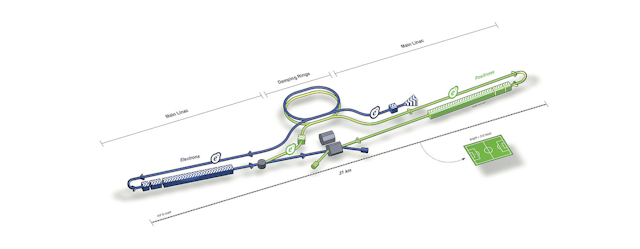While the world’s most powerful particle accelerator - the Large Hadron Collider (LHC) - is on a two-year hiatus for repairs and upgrade, engineers are getting ready to construct the next generation of particle accelerator: the International Linear Collider (ILC).
On Wednesday, a team of around 2,000 scientists and engineers from three hundred universities around the world (the Linear Collider Collaboration) published the ILC Technical Design Report. The report describes the physics case to build the new collider, as well as the accelerator’s design and the sophisticated experiments it’s tipped to run.
When constructed, the 31km-long ILC will be the world’s longest linear accelerator. That record is currently held by the Stanford Linear Accelerator in the US, which is 3.2km long.
Both the Large Hadron Collider and the proposed International Linear Collider work by smashing particles at high speeds.
But, you may ask, why do we need a new collider when the Large Hadron Collider will only be out of action for two years?
The structure of the International Linear Collider
As its name suggests, the International Linear Collider will mainly consist of two linear accelerators, facing each other. Electrons in one accelerator and positrons in the other will travel at very high speeds (approaching the speed of light) before colliding at the centre of the 31km-long machine.
When fully operational, there will be approximately 7,000 electron-positron collisions per second in the new machine. The acceleration will be provided by 7,400 superconducting radio-frequency cavities placed along the length of the structure, and, like the LHC, will operate at temperatures near absolute zero.
The electrons and positrons will travel in bunches, with each bunch containing 20 billion electrons or positrons concentrated into an area much smaller than that of a human hair. The number of collisions per second will be very high and this is crucial to produce and study particles which rarely occur in nature.

LHC and ILC: different, but complementary
While collisions at the Large Hadron Collider offers a broad view that can reveal new particles and new processes, collisions at the International Linear Collider can reveal specific properties and detailed information. The two types of collider rely on each other. We need both if we are to get to the bottom of the fundamental questions in nature.
In simple terms, if the Large Hadron Collider is considered the discovery machine, the International Linear Collider will be the precision machine. Both are required to complement each other’s findings.
The LHC smashes complex particles (protons) - which are made up of many smaller particles - resulting in very messy collisions with lots of particles spraying everywhere. In contrast, the ILC will smash indivisible particles - electrons and positrons - which will produce very clean collisions. The video below explains how the LHC and ILC collisions will differ.
The new machine will (hopefully!) shed more light on the recently observed Higgs boson and make important contributions to the search for particles associated with dark matter.
It’s also likely to make precise measurements of top quark mass - the heaviest particle of the Standard Model of Physics - in a way not possible at circular hadron colliders such as LHC.
To capture the outcomes of the particle collisions, the ILC will use two sophisticated detectors, namely:

- SiD (Silicon Detector)
- ILD (International Large Detector)
The proposed two-detector design is essential to provide the corroboration of findings in an independent way. These technologically advanced multipurpose detectors will share “one” interaction region using a push-pull approach under which only one detector would record data at a time.
At regular intervals, the detectors would switch positions so the other could then record data. This is in contrast to LHC, which hosts four major detectors placed at four interaction regions on its 27km ring.
So now what?
The Technical Design Report is a result of approximately two decades of hard work, and clearly emphasises the importance of building the new machine.
The next steps are to choose a suitable site to build the International Linear Collider - most probably Japan or the US - which then will be followed up with any necessary site-dependent design details. Construction should start within two to five years.
So even though it’s still relatively early days, one of the most exciting scientific projects ever conceived is poised to begin.

